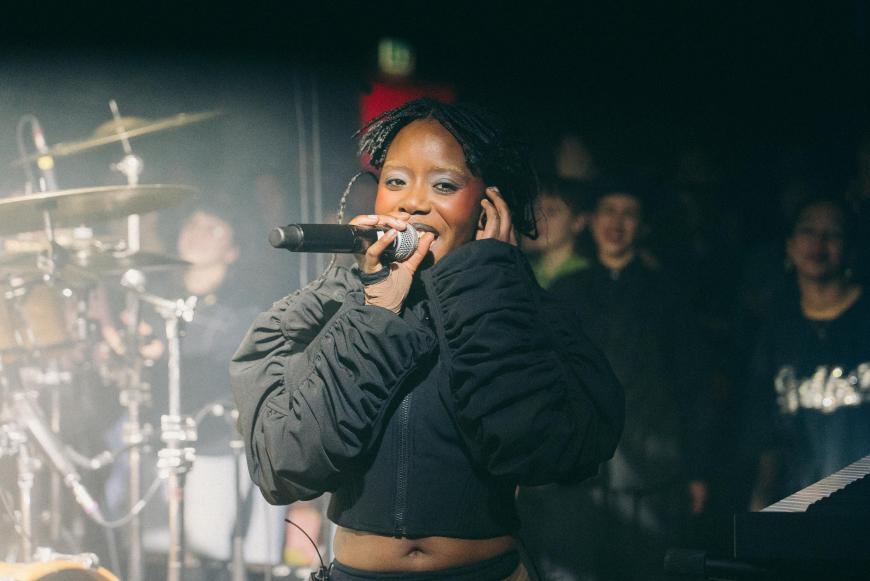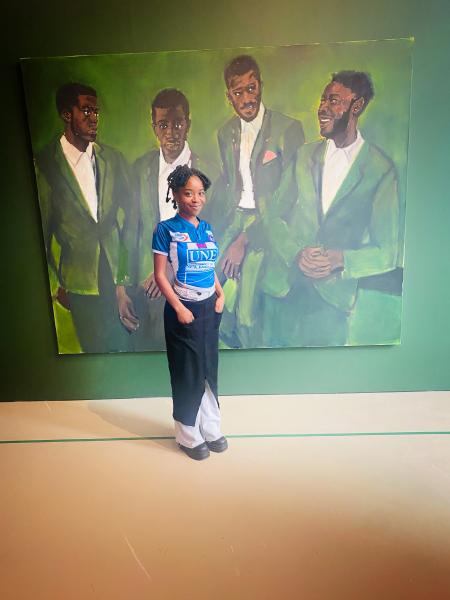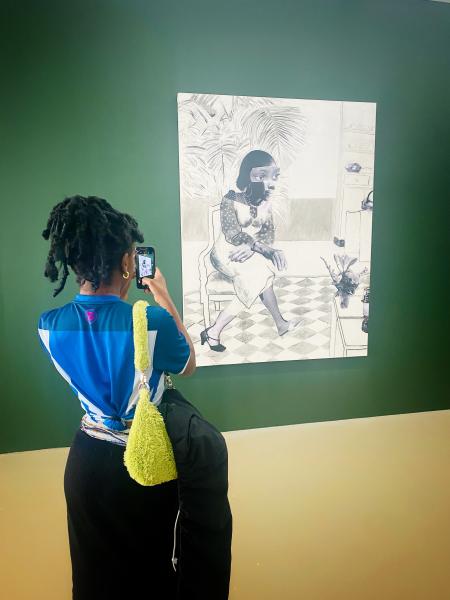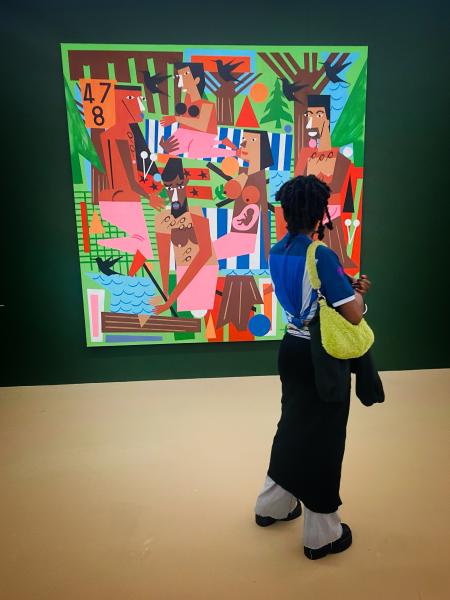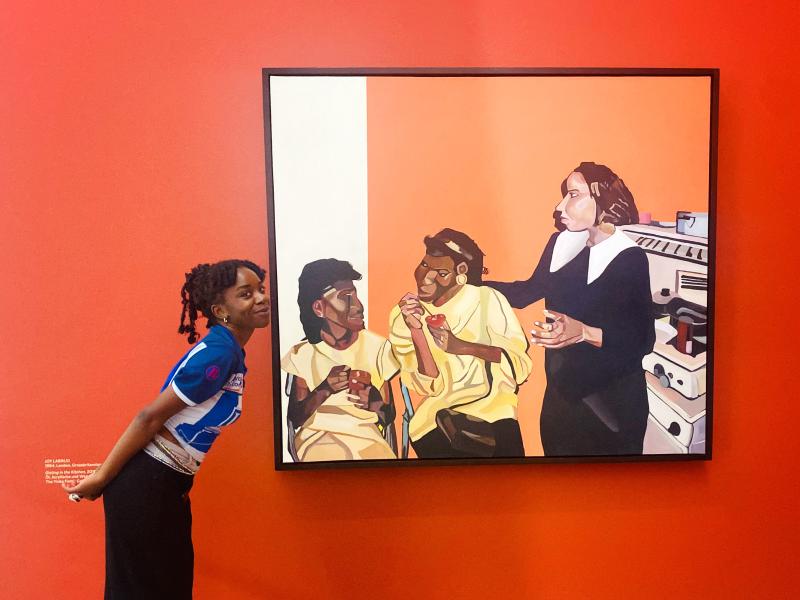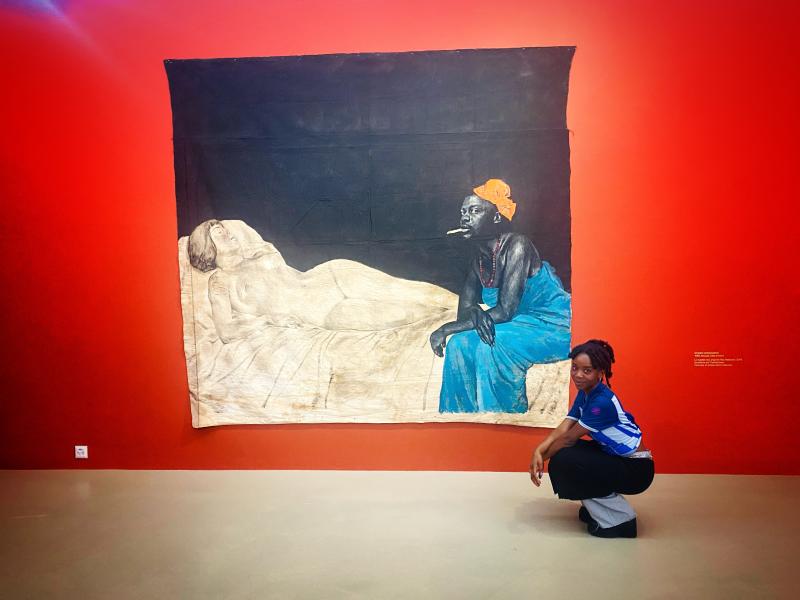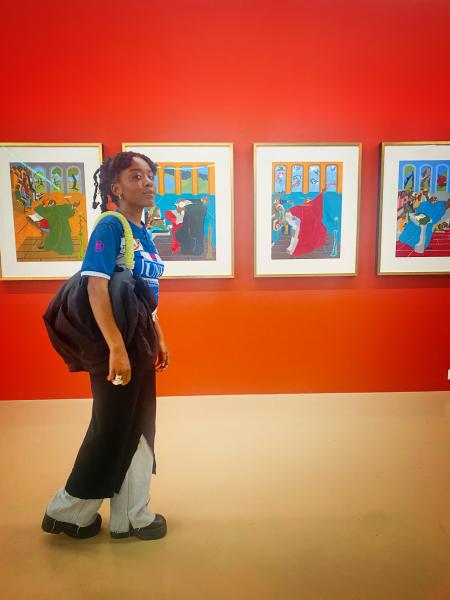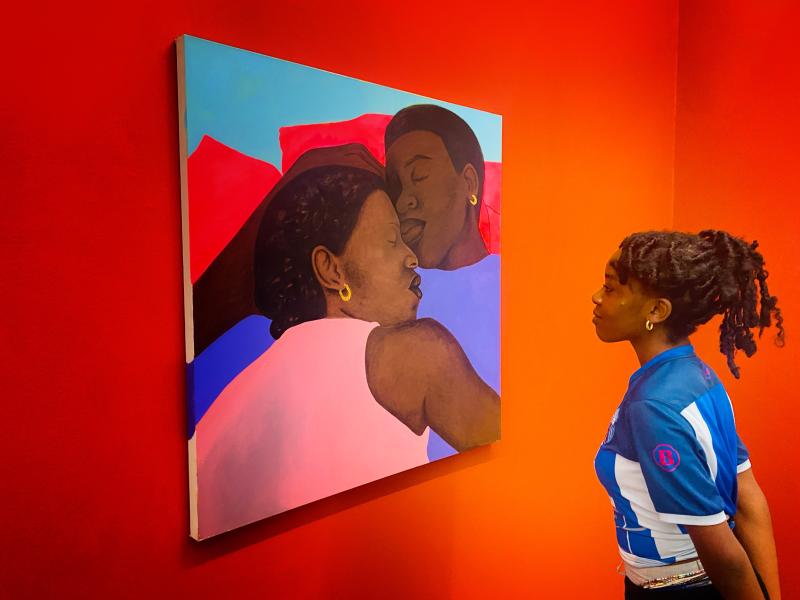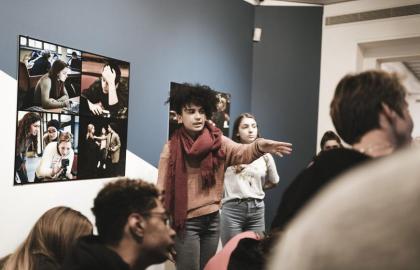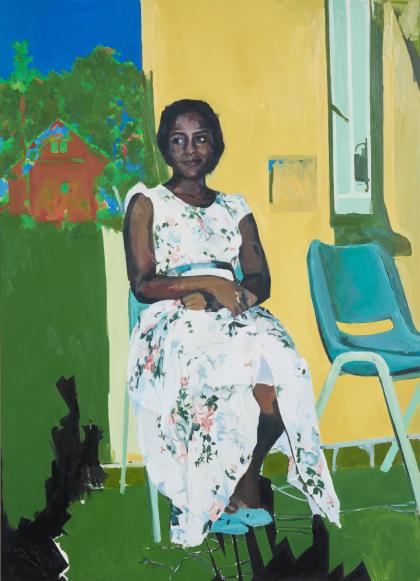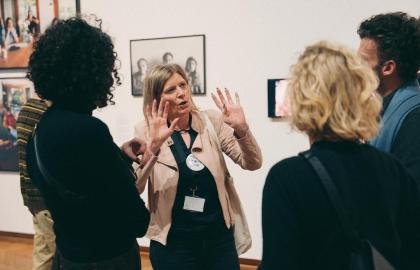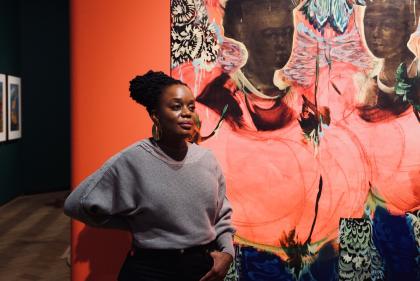Vitra Design Museum! Tinguely Museum! Float down the Rhine! Switch off your data roaming! Once my friends on social media realise that I’ve landed in Basel, there’s no shortage of tips. Only this isn’t a social call, because along with me, Martha Da’ro has also arrived in the Swiss and damn charming city. We’re here for a whistlestop tour of the exhibition When We See Us – an impressive hundred-year survey of black figuration in painting from Africa and the African diaspora. The exhibition is enjoying a five-month run at the Kunstmuseum Basel, after making its debut at Zeitz MOCAA in Cape Town. Next stop: Bozar.
To describe When We See Us as an important page in the still rather white history of the Brussels art temple would be an understatement. Nor is it an exaggeration to call it a seminal moment in art history, because the exhibition is as unique as it is magnificent. Trust me, it will still be discussed in ten, twenty, even thirty years’ time.
Or, as Martha Da’ro stated the day after her visit, still visibly moved: “This was incredibly invigorating and powerful! And I don’t just mean as an artist, but also on a personal level. I don’t think I’ve ever looked up and followed so many artists on Instagram in a single afternoon.” She laughs. “It felt like the moon and the stars were aligned, because I absolutely needed to discover all these works and artists.”
For those who don’t yet know Martha Da’ro (born Martha da Rosa Canga Antonio): she broke through in 2015, at the age of twenty, when she played the lead in Adil El Arbi and Bilall Fallah’s indie darling Black. She then landed notable roles in films such as Eva Cools’ Cleo and the TV series Roomies. The Netflix hit Lupin soon followed. But just as importantly, the Brussels-based artist released the exceptional EP Cheap Wine & Paris in 2020, followed by the equally soulful, passionate and rousing album Philophobia in 2023.
But now we’re in Basel for an exhibition of figurative painting, which is surely less familiar territory. Right? “I’ve already done some painting too,” she admits, reluctantly at first. “Hold on.” She dives into her mobile phone to pull up, minutes later, pictures of some wonderfully colourful and wacky paintings that don’t look anything like first attempts. “They’re already a few years old, but I might pick it up again one day. When We See Us has left me itching to get back to it.”
Kitchen secrets
When We See Us is the brainchild of Koyo Kouoh and Tandazani Dhlakama, whom Martha also met up with in Basel. Moments before, we’d been discussing the title of the exhibition – a title that feels like a statement to me, but an invitation to Martha. “The title puts a spin on When They See Us by Ava DuVernay,” explains Koyo Kouoh. It’s the title of a compelling Netflix series on the Central Park Five, five young black guys who were wrongly identified and convicted of raping a woman in Central Park in the 1980s. Because that was how ‘they’ were seen by the US media and New York police.
“The series focused, like so many other black stories, on trauma,” Koyo continues, “and that’s something we wanted to avoid. By changing ‘they’ to ‘we’, we realised that we could flip the discourse and appropriate it in a relatively simple way. On the one hand, it’s a statement, but on the other, it’s a genuine invitation. Because we’re deliberately moving away from the ‘us-against-them’ discourse that many people, understandably, are uncomfortable with.”
At the same time, collective black power does also emanate from the exhibition, adds the curator. And joy. An abundance of joy. “You really feel that,” says Martha, who was born in Mons, Belgium but has Angolan roots. “The works are filled with joy. It’s such a powerful sensation that you can’t help but feel happy too.” She lingers before a work by the British-Nigerian artist Joy Labinjo: Gisting in the Kitchen. “The colours alone are beautiful, but what I love the most is that the work seems to depict three generations of women. They’re just chatting in the kitchen. It’s such a poignant reminder of those endless conversations, about everything and nothing, that I had with my own mother and aunt – in the kitchen, of course.”
The works are filled with joy. It's such a powerful sensation that you can't help but feel happy too.
Slightly further on, Martha encounters several works by the late African-American artist Jacob Lawrence, depicting an impassioned priest in the midst of a sermon. “At a young age, I often went to church with my parents,” she recalls, “and the priest’s gestures and expression catapulted me straight back to that time. Preaching is truly an art, you know, a performance. You work with a book that anyone can read, but that’s not the point. It’s all about how you tell the stories within. A good priest can convey the entire gamut of human emotion. As in this work. Not to mention those colours, yes. I love colour!”
I can’t help but wonder whether the origins of Martha’s singing and acting career lie in her early church-going. She hesitates. “M-a-a-a-y-be. Music is a fundamental part of a church service. It doesn’t matter whether you’re in the choir or not: you’re still part of the event. Singing, dancing, you really give your all.” There’s no singing in the exhibition. Dancing, though, that’s another story. “Oh, this is such a great song,” says Martha, sashaying past. It turns out to be ‘Voodoo Woman’ by Bill Fleming, as the music app Shazam tells me. And it’s part of the exhibition soundscape, which was curated by the South African composer and sound artist Neo Muyanga.
“Music is central to every artist’s life,” Koyo explains. “Just look at the work of Congolese painters such as Moké and Chéri Samba, and you can’t help but notice the rhythm.” But this isn’t the only reason why the curator pursued music in the exhibition spaces: “Music also played an important role in the civil rights movement, in the struggle for liberation and in all forms of black consciousness. Working with music for this exhibition was a real no-brainer.” Moreover, Muyanga didn’t just select any old catchy tunes, as co-curator Tandazani Dhlakama explains. “He dug deep to find important music risked being forgotten or was even banned at a certain point. Moreover, the songs correspond to the various themes of the exhibition, all of which are manifestations of ‘black joy’. It’s not a random selection, it is a sonic translation of the themes of the exhibition.”
Reclining nude
In case you were wondering, the themes in When We See Us are: The Everyday, Joy and Revelry, Repose, Spirituality, Triumph and Emancipation and – Martha Da’ro’s favourite – Sensuality. “I’m particularly fascinated by the latter theme because there are so many bodies at rest in this exhibition,” says the Brussels-based artist. “It’s a rare sight. And there is nothing more sensual than people feeling comfortable in their skin.”
She lingers, for what seems like an age, before Espero que ya le dijiste a tu madre de nosotras (2020) by Tiffany Alfonseca. “I hope you’ve told your mother about us,” says Martha, translating the title with assurance. Upon noticing my puzzled look, she smiles. “I speak five languages: Dutch, French, English, Spanish and – the official language of Angola – Portuguese.” The work depicts two reclining bodies, entwined in each other’s arms. “Two women,” Martha asserts, “because the title says ‘nosotras’. This work is so rich. The intensity of that moment, a moment in time, just the two of them, before they have to face the world again. You don’t even need to know the painting’s title to feel that it captures an entire story – an existing story, who knows? But of course, the title makes it complete.”
The exhibition also includes Le modèle noir, d’après Félix Vallotton (2019) by Roméo Mivekannin – a monumental canvas that ushers in the Sensuality theme. “I love huge canvases,” Martha admits. Several times. “But here, what really catches my eye, more than anything else, is the man’s gaze. I just read that it’s a portrait of the artist. Which makes the entire work even more fascinating. What is he doing, sitting there?” Koyo Kouoh is only too happy to answer the question, because it’s both a tantalising image – a black man sitting at the end of a bed, on which a colourless woman reclines – and clearly also an overt criticism of Western art history. “It’s a well-known motif in painting,” explains the curator, “the reclining nude. Or at least in the Western art world.” To take it further: a white male fantasy. Like Édouard Manet’s Olympia from 1863, which not only depicts a white, female nude, but also a black maid. However, the latter is so deep in the background that, for a long time, she was barely mentioned by art critics. Until Félix Vallotton made his own interpretation of the painting in 1913 and transformed the maid into a self-confident black woman. She sits at the end of the bed, completely chill, gazing at the naked woman in repose. Roméo Mivekannin, in turn, steered that work in yet another direction by virtually erasing the naked woman, casting himself as the assured black woman, and looking the viewer straight in the eye. “His assertiveness, the fearlessness with which he claims a place in art history, it really determined the choices we made in curating this exhibition,” Koyo says.
That fearlessness, by the way, also informs Mivekannin’s play on gender in this painting. And he is – remarkably – far from the only artist to tread this path in the exhibition. “I’m also convinced that it’s something that’s been around forever,” says Martha. “A third gender, genderlessness, ... Nowadays, we’ve invented all kinds of names and labels for it, which means that it’s officially found a place in the world and is also discussed a lot more. But I genuinely believe it’s of all times.”
Small everyday things are easy to overlook because we see them as mundane, but they are the source of untold pleasure.
Eye-opener
After our three-hour tour of the exhibition, we escape to the roof of the Kunstmuseum Basel to catch our breath. And to enjoy a view of the Rhine, at least. (Floating down the river will be for another day.) “It was a lot, but I can’t wait to see the show in Brussels for a second time AND to bring all my friends along,” Martha says excitedly. “They’re going to love this too!” Truth be told, it’s hard to imagine anyone not being blown away by When We See Us. This jaw-dropping exhibition – with over 150 works by approximately 120 artists – is a real eye-opener.
“One of the things we’ve tried to do,” concludes Tandazani, “is to demonstrate that countless Black artists over the past one hundred years have also made work which refuses to centralise whiteness and refuses to centralise trauma. Black artists from all over the world within different black geographies have made work about mundane things that depict the a daily lives just like other artist have done. This exhibition is really a celebration of the Black canon. People have used painting to express emotion, to reflect upon themselves and to tell their truth since time immemorial. And that’s no different in Africa and the African diaspora.”
Martha adds that this is also what she loves the most about the exhibition: “I adore snapshots. Small, everyday things that are easy to overlook because we see them as ‘mundane’ rather than ‘joyful’. But if we stop to think about it, for just five seconds, we’d see that they are the source of untold pleasure.” Tandazani believes that this might be why the exhibition feels so timeless and – above all else – universal. “It’s a celebration of life,” says the curator, “and everyone is invited to come and celebrate with us.”
The exhibition When We See Us runs from 7 February to 10 August 2025.

